Modeling Rainfall-Runoff Response to Land Use and Land Cover Change in Rwanda (1990–2016)
Abstract
:1. Introduction
2. Materials and Methods
2.1. Description of the Study Area
2.2. Model Description
2.3. Model Inputs and Scenario Design
2.3.1. Long-Term Mean Annual Rainfall Intensity
2.3.2. Developing Land Use and Land Cover Maps for Rwanda
2.3.3. Soil Textural Classification Map
2.3.4. Slope Map
2.4. Wet Season’s Rainwater Runoff Reservation for Irrigation
3. Results
3.1. Land-Use Change from 1990 to 2016
3.2. The Temporal Patterns of Runoff Depth from 1990 to 2016
3.3. The Spatial Pattern in Runoff Change during the Period 1990–2015
4. Discussion
4.1. Land Use and Land Cover Change Impact on Rainfall Runoff in Rwanda
4.2. Potential Benefits of Rainfall Runoff Management in Rwanda
4.3. Uncertainities
5. Conclusions
Acknowledgments
Author Contributions
Conflicts of Interest
Abbreviations
| ha | hectare |
| mm | millimeter |
| Km | Kilometer |
| RWF | Rwandan Franc |
| € | Euro |
Appendix A
| District | LCLU Extent 2016 (km2) | LCLU Change 1990–2016 (km2) | |||||||||||
|---|---|---|---|---|---|---|---|---|---|---|---|---|---|
| Names | Coverage (%) | Forestland | Grassland | Cropland | Built-Up Land | Wetland | Water | Forestland | Grassland | Cropland | Built-Up Land | Wetland | Water |
| Bugesera | 5.11 | 52.06 | 129.56 | 810.71 | 44.59 | 180.36 | 79.28 | −151.14 | −318.36 | 453.16 | 40.33 | −25.11 | 0.95 |
| Burera | 2.55 | 92.35 | 26.45 | 406.54 | 8.15 | 52.74 | 60.05 | −247.10 | −20.38 | 255.47 | 8.15 | 0.05 | 4.15 |
| Gakenke | 2.78 | 119.88 | 76.71 | 485.55 | 19.91 | 0.58 | 2.50 | −366.70 | 49.02 | 299.85 | 19.90 | −2.39 | 0.42 |
| Gasabo | 1.70 | 86.00 | 36.04 | 252.08 | 49.19 | 4.17 | 2.84 | −114.21 | −15.59 | 116.51 | 14.10 | −0.85 | −0.01 |
| Gatsibo | 6.26 | 202.66 | 444.58 | 766.23 | 9.34 | 128.54 | 37.60 | −241.75 | −328.62 | 558.92 | 6.06 | 9.14 | −3.77 |
| Gicumbi | 3.27 | 258.17 | 60.43 | 495.56 | 6.87 | 7.09 | 2.23 | −135.21 | −17.46 | 144.39 | 6.87 | 1.54 | 0.00 |
| Gisagara | 2.69 | 56.92 | 44.40 | 530.58 | 8.48 | 39.79 | 1.21 | −142.14 | 41.14 | 125.07 | 8.17 | −27.86 | −5.00 |
| Huye | 2.30 | 23.89 | 89.95 | 452.04 | 10.54 | 5.15 | 0.44 | −142.70 | 88.91 | 43.96 | 4.70 | 5.17 | 0.18 |
| Kamonyi | 2.61 | 23.89 | 44.36 | 556.76 | 10.04 | 24.26 | 1.80 | −217.52 | −11.68 | 225.44 | 8.73 | −2.67 | −2.36 |
| Karongi | 3.90 | 147.32 | 91.10 | 533.41 | 16.74 | 0.13 | 201.32 | −380.66 | 34.62 | 328.33 | 15.86 | −0.27 | 2.21 |
| Kayonza | 7.64 | 195.67 | 779.25 | 608.95 | 10.02 | 185.02 | 159.55 | −248.12 | −290.64 | 554.21 | 8.92 | −20.99 | −4.20 |
| Kicukiro | 0.66 | 9.14 | 7.03 | 100.91 | 32.51 | 16.06 | 1.77 | −53.68 | −6.11 | 65.73 | 1.52 | −7.74 | 0.14 |
| Kirehe | 4.70 | 131.76 | 300.95 | 592.90 | 11.41 | 115.12 | 39.93 | −274.95 | −277.76 | 536.64 | 11.40 | 4.38 | −0.48 |
| Muhanga | 2.55 | 88.69 | 55.07 | 484.67 | 7.42 | 7.54 | 4.20 | −322.87 | 28.18 | 284.29 | 5.05 | 4.22 | 1.39 |
| Musanze | 2.08 | 127.87 | 26.99 | 332.03 | 22.84 | 0.00 | 18.37 | −211.23 | −16.14 | 205.81 | 20.96 | 0.00 | 0.70 |
| Ngoma | 3.44 | 74.11 | 155.28 | 482.10 | 7.40 | 89.99 | 62.33 | −397.04 | 5.28 | 399.34 | 2.50 | −14.67 | 4.76 |
| Ngororero | 2.67 | 61.75 | 73.79 | 519.88 | 20.61 | 0.15 | 1.20 | −355.94 | 50.47 | 286.83 | 20.61 | −1.20 | −0.71 |
| Nyabihu | 2.12 | 105.51 | 48.32 | 362.69 | 19.21 | 0.00 | 2.74 | −254.06 | 19.05 | 213.57 | 18.80 | 0.00 | 2.90 |
| Nyagatare | 7.58 | 113.92 | 368.54 | 1315.72 | 12.20 | 99.12 | 13.41 | −167.90 | −992.98 | 1148.05 | 8.64 | 0.61 | 2.94 |
| Nyamagabe | 4.31 | 333.59 | 76.72 | 667.13 | 14.06 | 0.45 | 0.18 | −415.33 | 45.25 | 355.57 | 14.06 | 0.46 | 0.18 |
| Nyamasheke | 4.62 | 424.46 | 94.73 | 407.80 | 12.78 | 0.08 | 231.81 | −263.41 | 47.66 | 195.55 | 12.78 | 0.08 | 7.74 |
| Nyanza | 2.65 | 34.02 | 13.46 | 597.96 | 4.42 | 22.41 | 0.77 | −213.90 | −4.15 | 215.64 | 4.42 | −2.18 | 0.28 |
| Nyarugenge | 0.52 | 25.28 | 7.57 | 65.10 | 19.98 | 14.28 | 0.55 | −40.37 | −3.44 | 42.93 | 4.38 | −1.73 | −1.89 |
| Nyaruguru | 3.99 | 304.14 | 208.08 | 496.96 | 3.13 | 0.06 | 0.07 | −255.77 | 170.94 | 82.45 | 3.13 | −0.62 | 0.04 |
| Rubavu | 1.53 | 55.70 | 53.89 | 189.08 | 40.49 | 0.00 | 47.46 | −217.17 | 40.06 | 141.02 | 35.85 | 0.00 | 0.27 |
| Ruhango | 2.47 | 12.57 | 10.56 | 587.16 | 3.75 | 12.60 | 0.39 | −180.68 | −38.44 | 207.78 | 3.75 | 7.78 | 0.05 |
| Rulindo | 2.24 | 72.56 | 18.58 | 466.19 | 10.38 | 0.24 | 0.47 | −236.38 | −4.57 | 231.69 | 10.37 | −0.65 | −0.42 |
| Rusizi | 3.79 | 451.22 | 71.48 | 365.19 | 21.65 | 0.89 | 50.14 | −154.68 | −19.56 | 145.52 | 21.65 | 0.91 | 6.61 |
| Rutsiro | 4.58 | 165.42 | 124.88 | 369.99 | 2.22 | 0.00 | 498.97 | −392.70 | 106.95 | 281.93 | 2.22 | 0.00 | 1.42 |
| Rwamagana | 2.69 | 48.01 | 93.45 | 485.65 | 11.45 | 15.37 | 28.73 | −294.71 | −76.91 | 358.10 | 11.14 | −0.42 | 3.02 |
| Rwanda | 100 | 3898.53 | 3632.20 | 14,787.52 | 471.78 | 1022.19 | 1552.31 | −7090.02 | −1715.26 | 8503.75 | 355.02 | −75.01 | 21.51 |
Appendix B
| Province | LCLU 2016 (Km2) | LCLU Change 1990–2016 (Km2) | LCLU Conversion 1990–2016 (Km2) | ||||||
|---|---|---|---|---|---|---|---|---|---|
| Names | Coverage (%) | Forestland | Grassland | Cropland | Forestland | Grassland | Cropland | Forest. to Crop. | Grass. to Crop. |
| Kigali | 2.88 | 120.49 | 50.59 | 94.93 | −208.27 | −25.14 | 225.17 | 183.12 | 55.40 |
| North | 12.92 | 671.15 | 208.99 | 496.32 | −1196.63 | −9.53 | 1137.19 | 1108.07 | 155.26 |
| South | 23.57 | 878.14 | 542.14 | 992.99 | −1890.91 | 320.17 | 1540.18 | 1791.06 | 122.97 |
| East | 37.42 | 818.58 | 2269.62 | 1149.44 | −1775.59 | −2280.01 | 4008.46 | 1404.90 | 2718.01 |
| West | 23.21 | 1412.07 | 557.71 | 623.98 | −2018.62 | 279.25 | 1592.75 | 1696.25 | 131.60 |
| Rwanda | 100 | 3900.43 | 3629.05 | 3357.66 | −7090.02 | −1715.26 | 8503.75 | 6183.41 | 3183.24 |
References
- Goudie, A. The Human Impact on the Natural Environment; MIT Press: Cambridge, MA, USA, 2000. [Google Scholar]
- Tilman, D.; Fargione, J.; Wolff, B.; D’Antonio, C.; Dobson, A.; Howarth, R.; Schindler, D.; Schlesinger, W.H.; Simberloff, D.; Swackhamer, D. Forecasting agriculturally driven global environmental change. Science 2001, 292, 281–284. [Google Scholar] [CrossRef] [PubMed]
- Karamage, F.; Shao, H.; Chen, X.; Ndayisaba, F.; Nahayo, L.; Kayiranga, A.; Omifolaji, J.K.; Liu, T.; Zhang, C. Deforestation effects on soil erosion in the lake kivu basin, dr congo-rwanda. Forests 2016, 7, 281. [Google Scholar] [CrossRef]
- Weng, Q. Modeling urban growth effects on surface runoff with the integration of remote sensing and gis. Environ. Manag. 2001, 28, 737–748. [Google Scholar] [CrossRef]
- UN. World Population Prospects: The 2015 Revision. Population Division, Desa. Available online: http://esa.un.org/unpd/wpp/ (accessed on 25 October 2016).
- Karamage, F.; Zhang, C.; Ndayisaba, F.; Shao, H.; Kayiranga, A.; Fang, X.; Nahayo, L.; Muhire Nyesheja, E.; Tian, G. Extent of cropland and related soil erosion risk in Rwanda. Sustainability 2016, 8, 609. [Google Scholar] [CrossRef]
- Habiyaremye, G.; Jiwen, G.; de la Paix Mupenzi, J.; Balogun, W.O. Demographic pressure impacts on forests in Rwanda. Afr. J. Agric. Res. 2011, 6, 4533–4538. [Google Scholar]
- Grinning Planet. Water Pollution Solutions. Available online: http://www.grinningplanet.com/2008/01-08/water-pollution-solutions-article.htm (accessed on 20 August 2016).
- Nezlin, N.P.; Digiacomo, P.M.; Stein, E.D.; Ackerman, D. Stormwater runoff plumes observed by seawifs radiometer in the southern California bight. Remote Sens. Environ. 2005, 98, 494–510. [Google Scholar] [CrossRef]
- Korkmaz, N.; Avci, M. Evaluation of water delivery and irrigation performances at field level: The case of the menemen left bank irrigation district in Turkey. Indian J. Sci. Technol. 2012, 5, 2079–2089. [Google Scholar]
- Anaba, L.A.; Banadda, N.; Kiggundu, N.; Wanyama, J.; Engel, B.; Moriasi, D. Application of SWAT to assess the effects of land use change in the Murchison Bay Catchment in Uganda. Comput. Water Energy Environ. Eng. 2017, 6, 24–40. [Google Scholar] [CrossRef]
- Munyaneza, O.; Majoro, F.; Hagenimana, E.; Usabyisa, W. Impact assessment of hillside rainwater harvesting ponds on agriculture income: Case study of ntarama sector in Rwanda. J. Water Resour. Prot. 2016, 8, 844. [Google Scholar] [CrossRef] [Green Version]
- Lacasse, S.; Nadim, F. Landslide risk assessment and mitigation strategy. In Landslides–Disaster Risk Reduction; Springer: Berlin/Heidelberg, Germany, 2009; pp. 31–61. [Google Scholar]
- Meyer, W.B.; Turner, B. Changes in Land Use and Land Cover: A Global Perspective; Cambridge University Press: Cambridge, UK, 1994. [Google Scholar]
- Karamage, F.; Zhang, C.; Kayiranga, A.; Shao, H.; Fang, X.; Ndayisaba, F.; Nahayo, L.; Mupenzi, C.; Tian, G. Usle-based assessment of soil erosion by water in the Nyabarongo River Catchment, Rwanda. Int. J. Environ. Res. Public Health 2016, 13, 835. [Google Scholar] [CrossRef] [PubMed]
- Nhapi, I.; Wali, U.; Uwonkunda, B.; Nsengimana, H.; Banadda, N.; Kimwaga, R. Assessment of water pollution levels in the Nyabugogo Catchment, Rwanda. Open Environ. Eng. J. 2011, 4, 40–53. [Google Scholar] [CrossRef]
- REMA. The Assessment of Economic Impacts of the 2012 Wet Season Flooding in Rwanda. Available online: http://www.rema.gov.rw/fileadmin/templates/Documents/rema_doc/Planing_Dpt/FINAL%20REPORT%20ECONOMIC%20IMPACT%20OF%202012%20WET%20SEASON.pdf (accessed on 20 November 2016).
- MIDIMAR. The National Risk Atlas of Rwanda. Available online: http://midimar.gov.rw/uploads/tx_download/National_Risk_Atlas_of_Rwanda.pdf (accessed on 15 August 2016).
- De la Paix, M.J.; Lanhai, L.; Jiwen, G.; de Dieu, H.J.; Gabriel, H.; Jean, N.; Innocent, B. Radical terraces in Rwanda. East Afr. J. Sci. Technol. 2012, 1, 53–58. [Google Scholar]
- Munyaneza, O. Space-Time Variation of Hydrological Processes and Water Resources in Rwanda: Focus on the Migina Catchment. Ph.D. Thesis, UNESCO-IHE, Institute for Water Education, Delft, The Netherlands, 7 May 2014. [Google Scholar]
- Liu, Y.; De Smedt, F. Wetspa Extension, a Gis-Based Hydrologic Model for Flood Prediction and Watershed Management; Documentation and User Manual; Vrije Universiteit Brussel: Brussel, Belgium, 2004. [Google Scholar]
- Mahmoud, S.H. Investigation of rainfall–runoff modeling for Egypt by using remote sensing and gis integration. Catena 2014, 120, 111–121. [Google Scholar] [CrossRef]
- Nagarajan, N.; Poongothai, S. Spatial mapping of runoff from a watershed using scs-cn method with remote sensing and gis. J. Hydrol. Eng. 2011, 17, 1268–1277. [Google Scholar] [CrossRef]
- Hong, Y.; Adler, R.F.; Hossain, F.; Curtis, S.; Huffman, G.J. A first approach to global runoff simulation using satellite rainfall estimation. Water Resour. Res. 2007, 43. [Google Scholar] [CrossRef]
- Artan, G.; Gadain, H.; Smith, J.L.; Asante, K.; Bandaragoda, C.J.; Verdin, J.P. Adequacy of satellite derived rainfall data for stream flow modeling. Nat. Hazards 2007, 43, 167–185. [Google Scholar] [CrossRef]
- Rwanda Natural Resources Authority (RNRA). National Land Use Planning Portal. Administrative Boundaries. Available online: https://rwandalanduse.rnra.rw/index.php?id=38 (accessed on 15 August 2015).
- Twagiramungu, F. Environmental Profile of Rwanda; Consultancy Report; European Commission: Kigali, Rwanda, 2006; p. 78. [Google Scholar]
- Ntwali, D.; Ogwang, B.A.; Ongoma, V. The impacts of topography on spatial and temporal rainfall distribution over Rwanda based on WRF model. Atmos. Clim. Sci. 2016, 6, 145. [Google Scholar] [CrossRef]
- United Nations (UN). World Urbanization Prospects: The 2014 Revision, CD-ROM Edition. Available online: http://esa.un.org/unpd/wpp/ (accessed on 4 September 2016).
- Van Engelen, V.; Verdoodt, A.; Dijkshoorn, K.; Van Ranst, E. Soil and Terrain Database of Central Africa-DR of Congo, Burundi and Rwanda (Sotercaf, Version 1.0); ISRIC-UGent-FAO: Wageningen, The Netherlands, 2006; Available online: http://www.isric.org/isric/webdocs/docs/ISRIC_Report_2006_07.pdf (accessed on 28 July 2016).
- Schueler, T.R. Controlling Urban Runoff: A Practical Manual for Planning and Designing Urban BMPs; Metropolitan Washington Council of Governments: Washington, DC, USA, 1987. [Google Scholar]
- Mitchell, G.; Lockyer, J.; McDonald, A. Pollution Hazard from Urban Nonpoint Sources: A Gis-Model to Support Strategic Environmental Planning in the UK; University of Leeds: Leeds, UK, 2001; Available online: http://www.geog.leeds.ac.uk/projects/nps/reports.htm (accessed on 25 June 2016).
- Funk, C.; Peterson, P.; Landsfeld, M.; Pedreros, D.; Verdin, J.; Shukla, S.; Husak, G.; Rowland, J.; Harrison, L.; Hoell, A.; et al. The climate hazards infrared precipitation with stations—A new environmental record for monitoring extremes. Sci. Data 2015, 8, 150066. [Google Scholar] [CrossRef] [PubMed]
- RCMRD. Land Cover Viewer: Eastern & Southern Africa. Available online: http://apps.rcmrd.org/landcoverviewer/ (accessed on 20 October 2016).
- United States Geological Survey (USGS). USGS Global Visualization Viewer: Earth Resources Observation and Science ceNter (EROS). Available online: http://glovis.usgs.gov/index.shtml (accessed on 20 September 2016).
- Otukei, J.R.; Blaschke, T. Land cover change assessment using decision trees, support vector machines and maximum likelihood classification algorithms. Int. J. Appl. Earth Obs. Geoinf. 2010, 12, S27–S31. [Google Scholar] [CrossRef]
- Basnet, B.; Vodacek, A. Tracking land use/land cover dynamics in cloud prone areas using moderate resolution satellite data: A case study in Central Africa. Remote Sens. 2015, 7, 6683–6709. [Google Scholar] [CrossRef]
- Anderson, J.R. A Land Use and Land Cover Classification System for Use with Remote Sensor Data; U.S. Government Printing Office: Washington, DC, USA, 1976; Volume 964.
- Long, J.B.; Giri, C. Mapping the Philippines’ mangrove forests using landsat imagery. Sensors 2011, 11, 2972–2981. [Google Scholar] [CrossRef] [PubMed]
- Bishop, Y.M.; Fienberg, S.E.; Holland, P.W. Discrete Multivariate Analysis: Theory and Practice; Massachusetts Institute of Technology Press: Cambridge, MA, USA, 1975. [Google Scholar]
- Mather, P.; Koch, M. Computer Processing of Remotely-Sensed Images: An Introduction; John Wiley & Sons: Hoboken, NJ, USA, 2011. [Google Scholar]
- Thomlinson, J.R.; Bolstad, P.V.; Cohen, W.B. Coordinating methodologies for scaling landcover classifications from site-specific to global: Steps toward validating global map products. Remote Sens. Environ. 1999, 70, 16–28. [Google Scholar] [CrossRef]
- Manandhar, R.; Odeh, I.O.; Ancev, T. Improving the accuracy of land use and land cover classification of landsat data using post-classification enhancement. Remote Sens. 2009, 1, 330–344. [Google Scholar] [CrossRef]
- Huang, C.; Goward, S.N.; Masek, J.G.; Thomas, N.; Zhu, Z.; Vogelmann, J.E. An automated approach for reconstructing recent forest disturbance history using dense landsat time series stacks. Remote Sens. Environ. 2010, 114, 183–198. [Google Scholar] [CrossRef]
- Adam, A.H.M.; Elhag, A.; Salih, A. Accuracy assessment of land use & land cover classification (lu/lc), case study of Shomadi Area, Renk County, Upper Nile State, South Sudan. Int. J. Sci. Res. Publ. 2013, 3, 1–6. [Google Scholar]
- Hengl, T.; Heuvelink, G.B.; Kempen, B.; Leenaars, J.G.; Walsh, M.G.; Shepherd, K.D.; Sila, A.; MacMillan, R.A.; de Jesus, J.M.; Tamene, L. Mapping soil properties of africa at 250 m resolution: Random forests significantly improve current predictions. PLoS ONE 2015, 10, e0125814. [Google Scholar] [CrossRef] [PubMed]
- Fernandez-Illescas, C.P.; Porporato, A.; Laio, F.; Rodriguez-Iturbe, I. The ecohydrological role of soil texture in a water-limited ecosystem. Water Resour. Res. 2001, 37, 2863–2872. [Google Scholar] [CrossRef]
- United States Geological Survey (USGS). U.S. Geological Survey Earthexplorer (ee) Tool. Available online: http://earthexplorer.usgs.gov/ (accessed on 20 September 2015).
- Munyaneza, O.; Nzeyimana, Y.K.; Wali, U.G. Hydraulic structures design for flood control in the Nyabugogo Wetland, Rwanda. Nile Basin Water Sci. Eng. J. 2013, 6, 2. [Google Scholar]
- Frenken, K.; Faurès, J.-M. Irrigation Potential in Africa: A Basin Approach; FAO Land and Water Bulletin, Vol. 4; Food & Agriculture Organization: Rome, Itay, 1997. [Google Scholar]
- Uwimbabazi, P.; Lawrence, R. Compelling factors of urbanization and rural-urban migration in Rwanda. Rwanda J. 2011, 22, 9–26. [Google Scholar]
- Krysanova, V.; Dickens, C.; Timmerman, J.; Varela-Ortega, C.; Schlüter, M.; Roest, K.; Huntjens, P.; Jaspers, F.; Buiteveld, H.; Moreno, E. Cross-comparison of climate change adaptation strategies across large river basins in Europe, Africa and Asia. Water Resour. Manag. 2010, 24, 4121–4160. [Google Scholar] [CrossRef]
- Meigh, J.; McKenzie, A.; Sene, K. A grid-based approach to water scarcity estimates for Eastern and Southern Africa. Water Resour. Manag. 1999, 13, 85–115. [Google Scholar] [CrossRef]
- Tschirley, D.; Nijhoff, J.J.; Arlindo, P.; Mwinga, B.; Weber, M.T.; Jayne, T.S. Anticipating and Responding to Drought Emergencies in Southern Africa: Lessons from the 2002–2003 Experience. In Proceedings of the NEPAD Regional Conference on Successes in African Agriculture, Nairobi, Kenya, 22–25 November 2004; pp. 22–25.
- Nabahungu, N.; Visser, S. Farmers’ knowledge and perception of agricultural wetland management in Rwanda. Land Degrad. Dev. 2013, 24, 363–374. [Google Scholar] [CrossRef]
- Karamage, F.; Zhang, C.; Ndayisaba, F.; Nahayo, L.; Kayiranga, A.; Omifolaji, J.K.; Shao, H.; Umuhoza, A.; Nsengiyumva, J.B.; Liu, T. The need for awareness of drinking water loss reduction for sustainable water resource management in Rwanda. J. Geosci. Environ. Prot. 2016, 4, 74. [Google Scholar] [CrossRef]
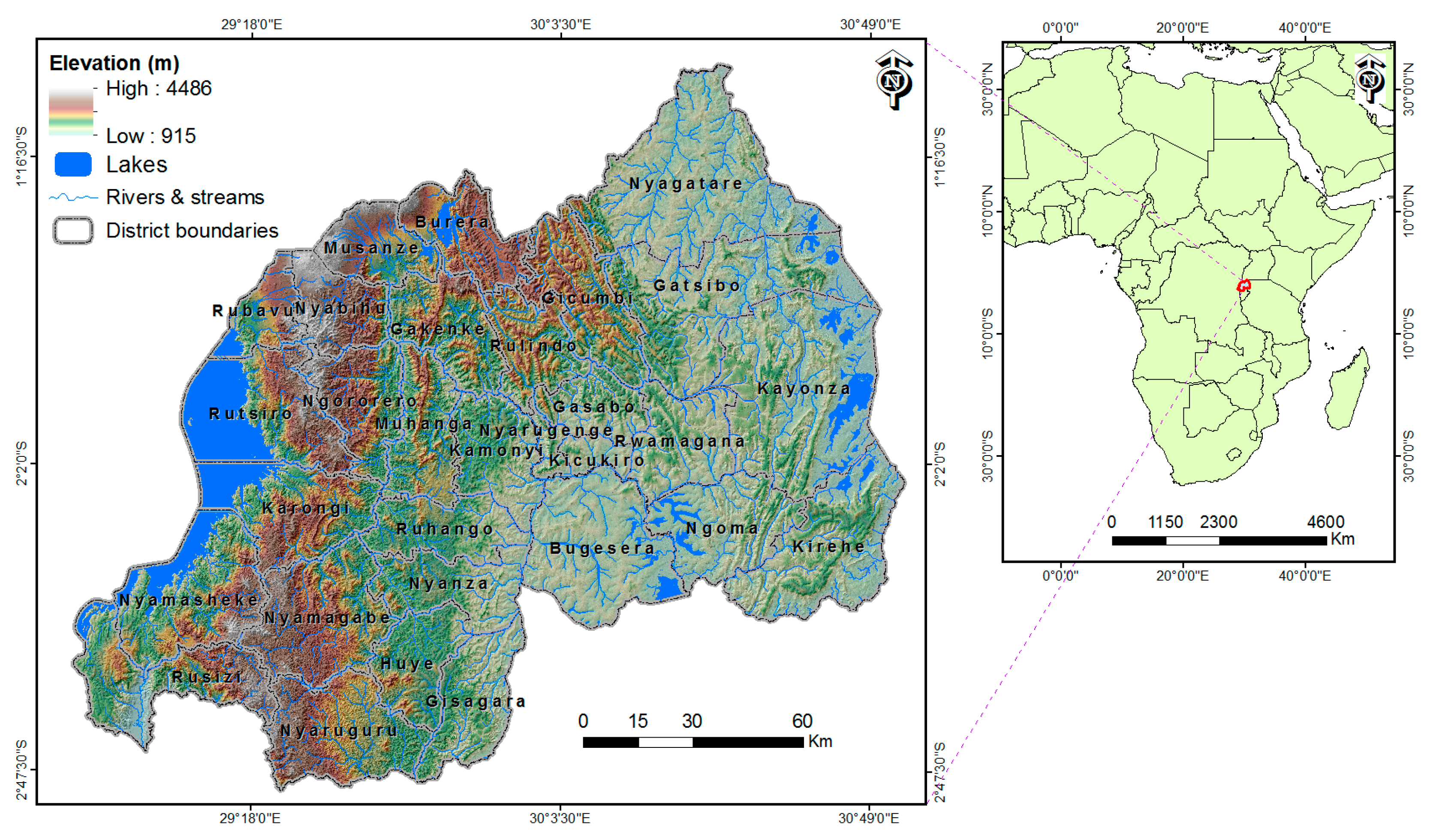

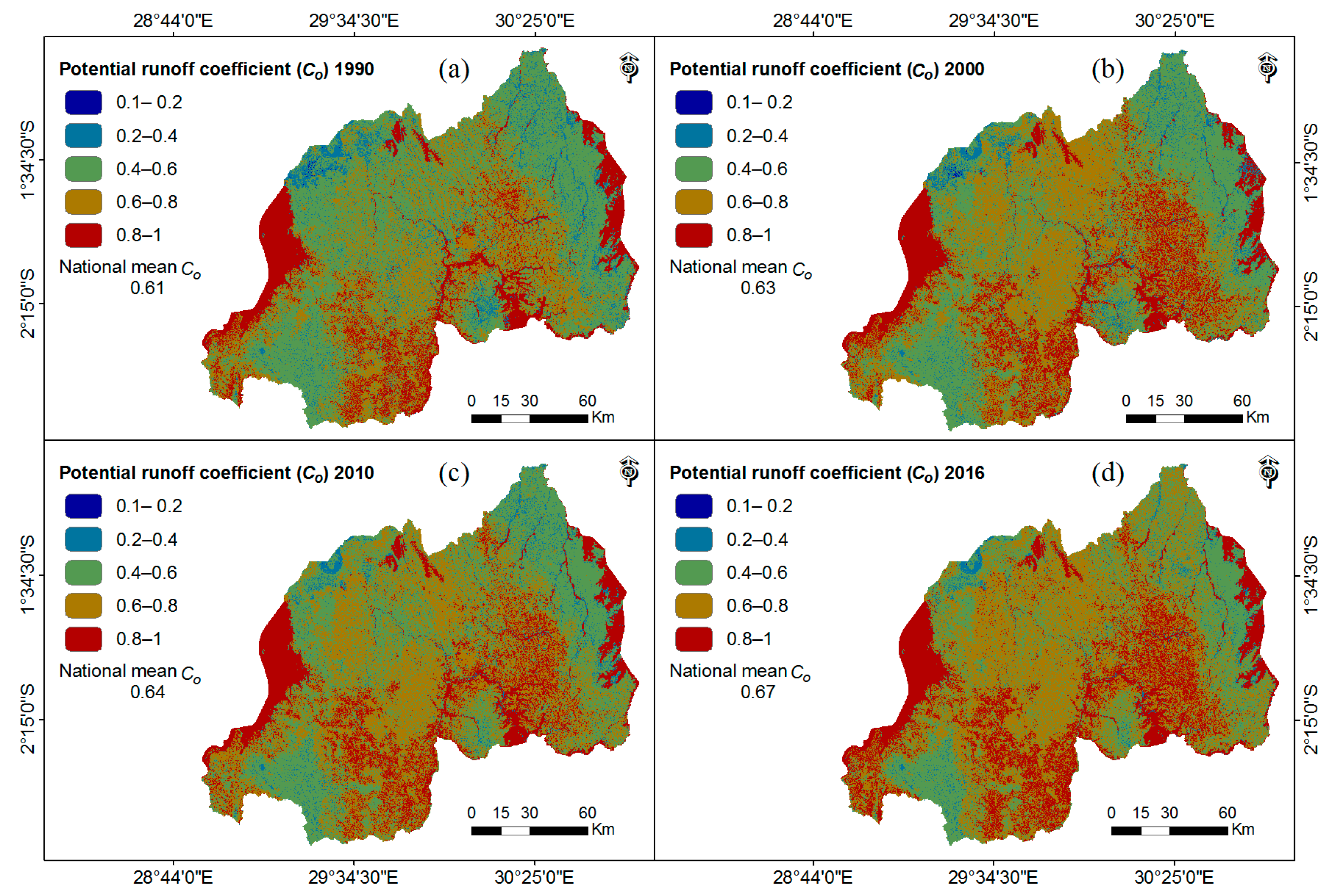
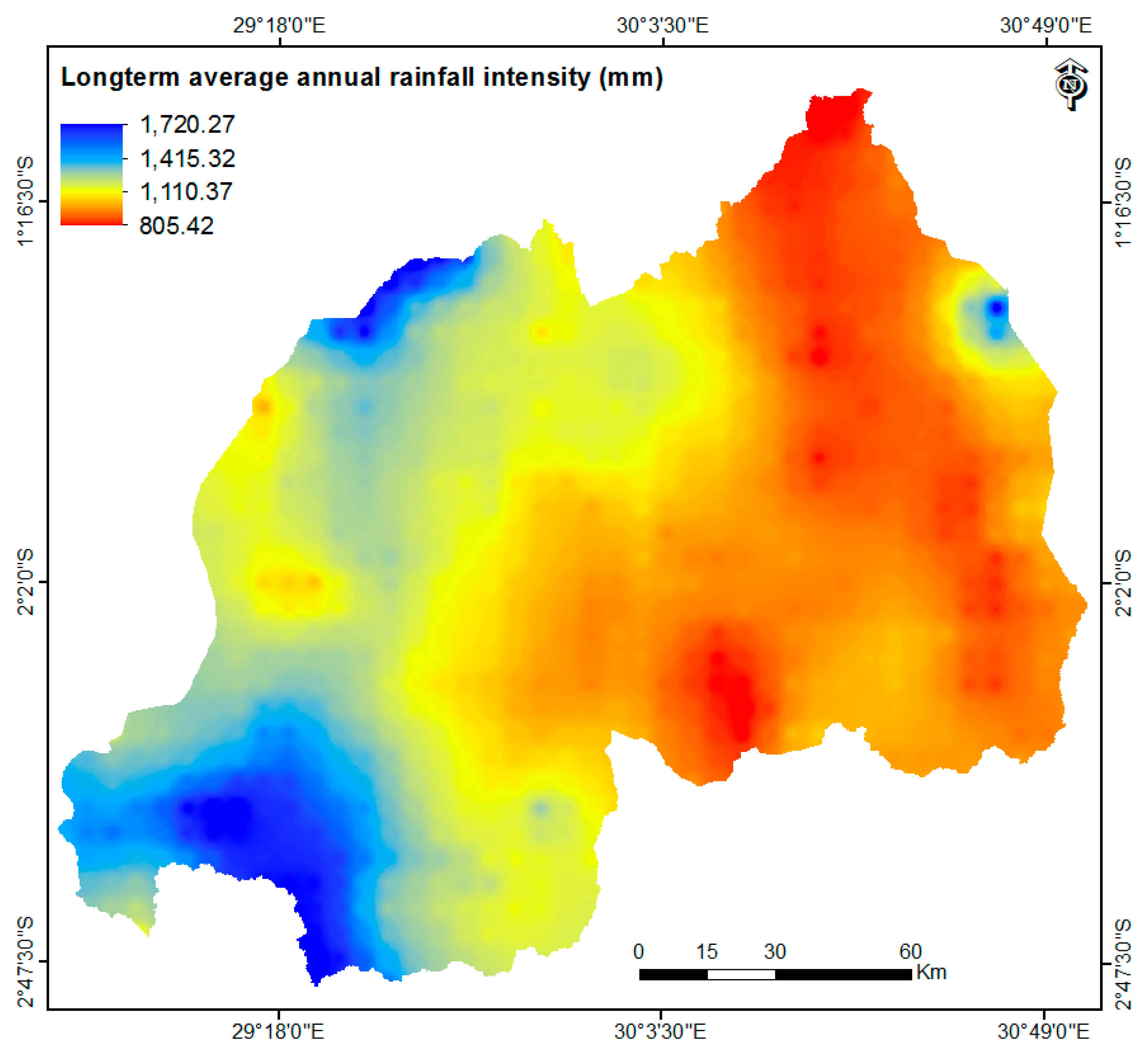

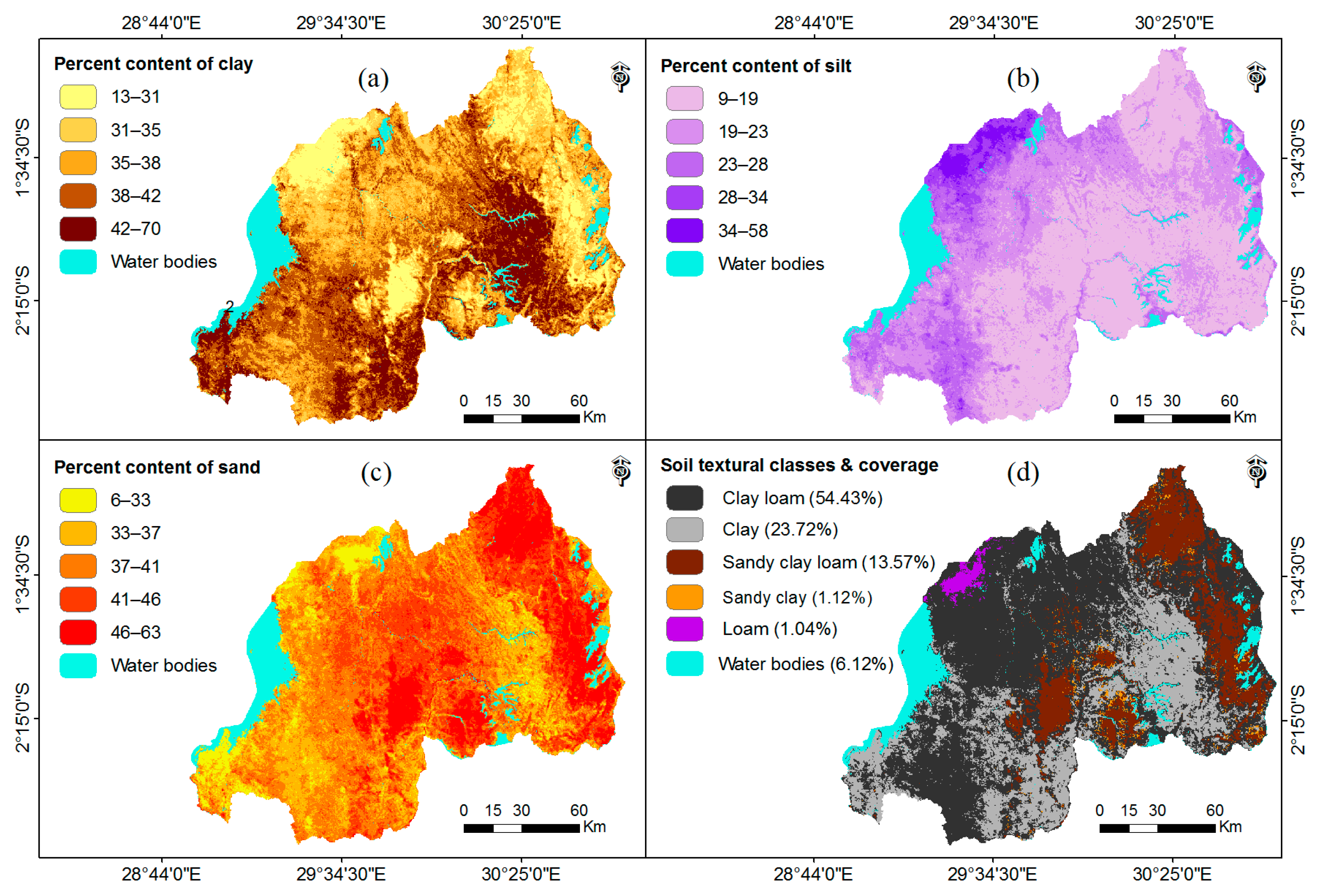
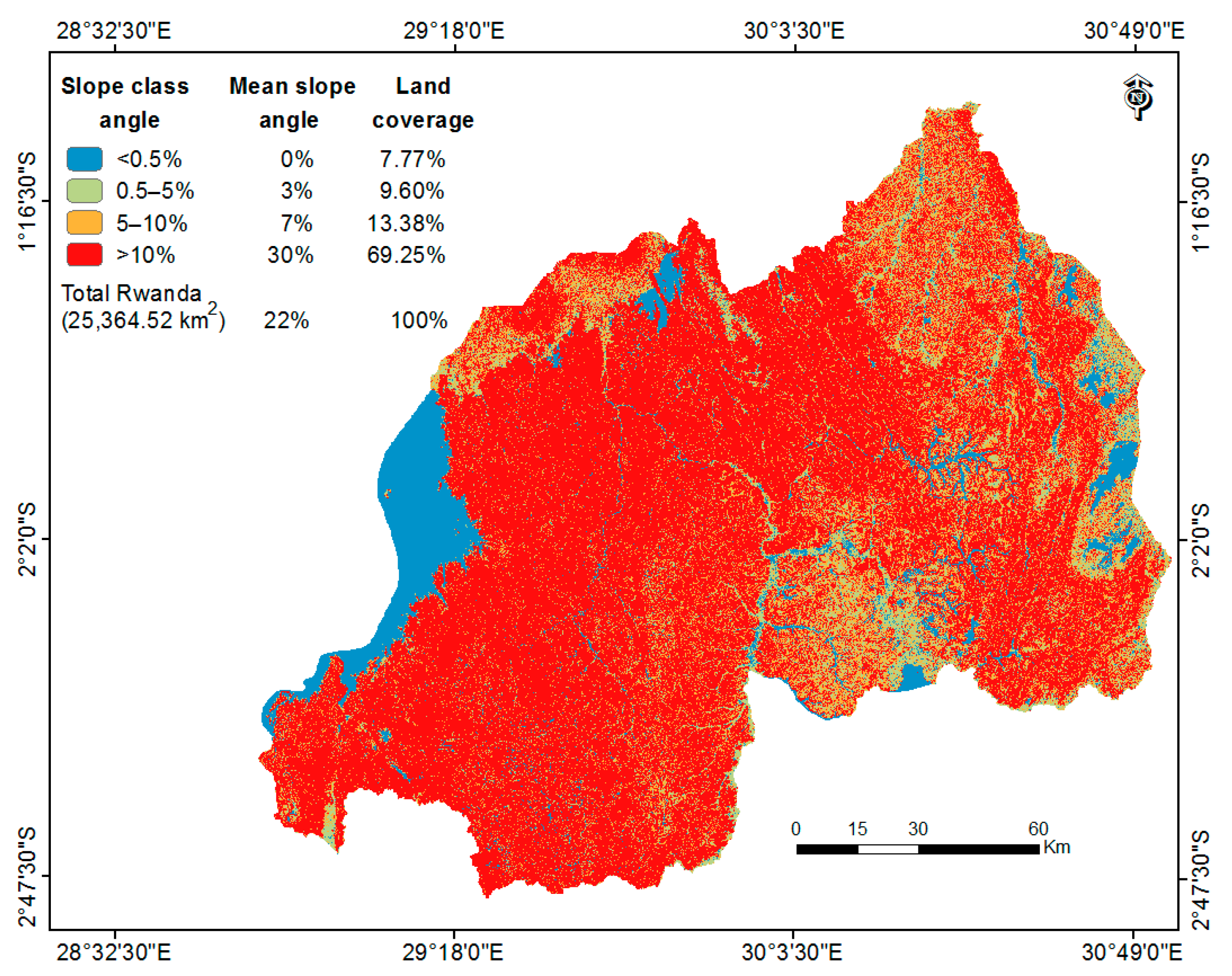
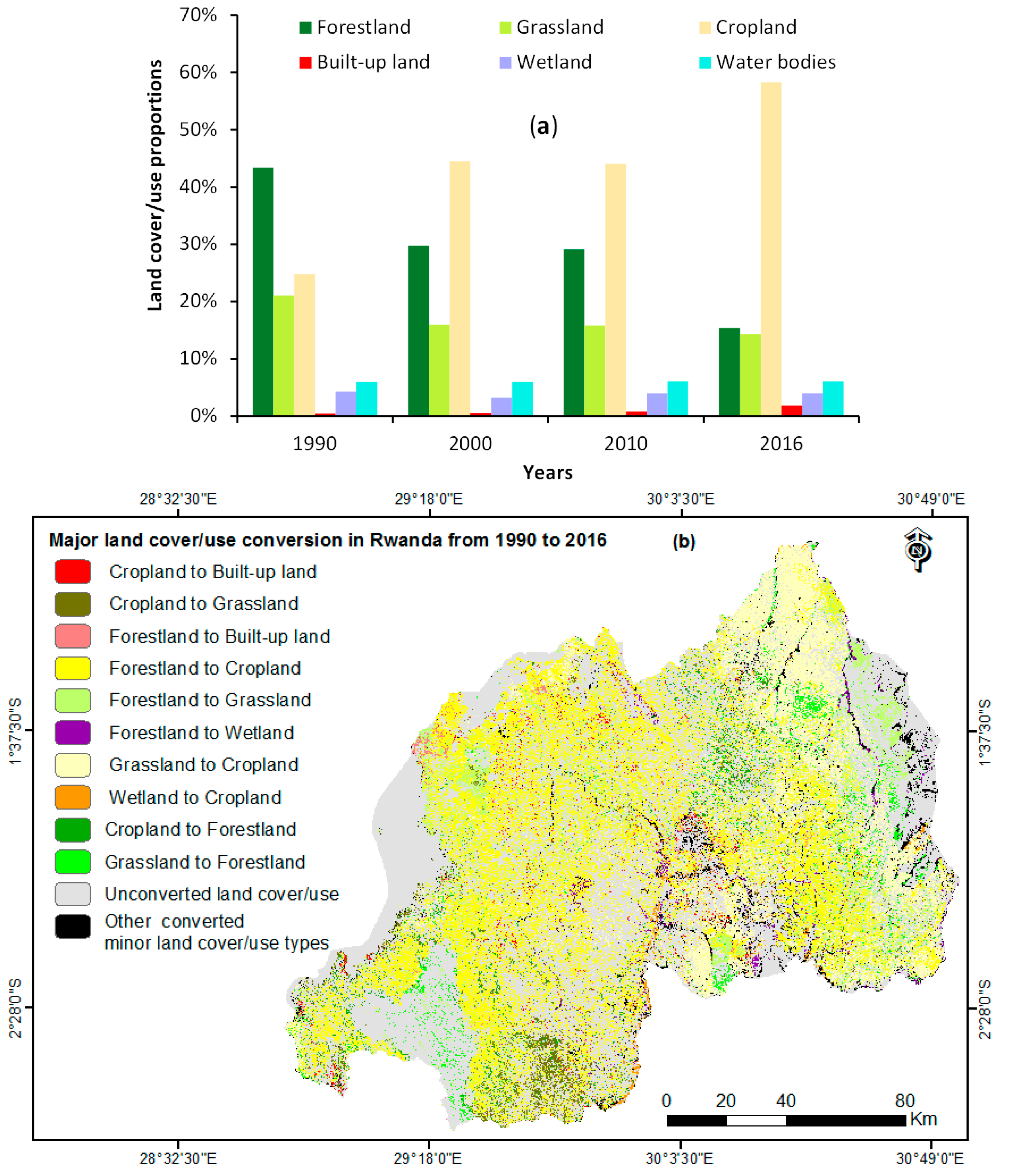
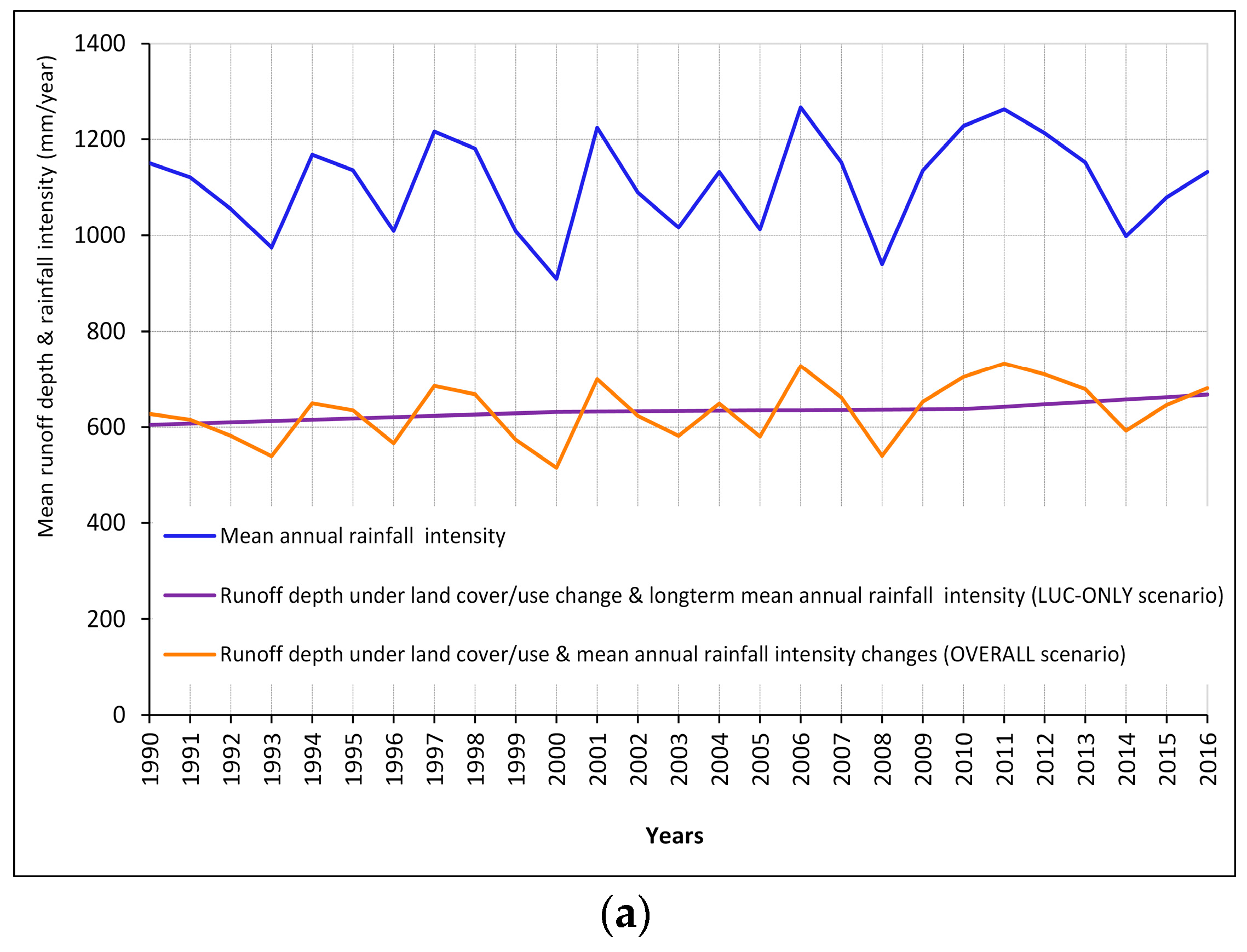
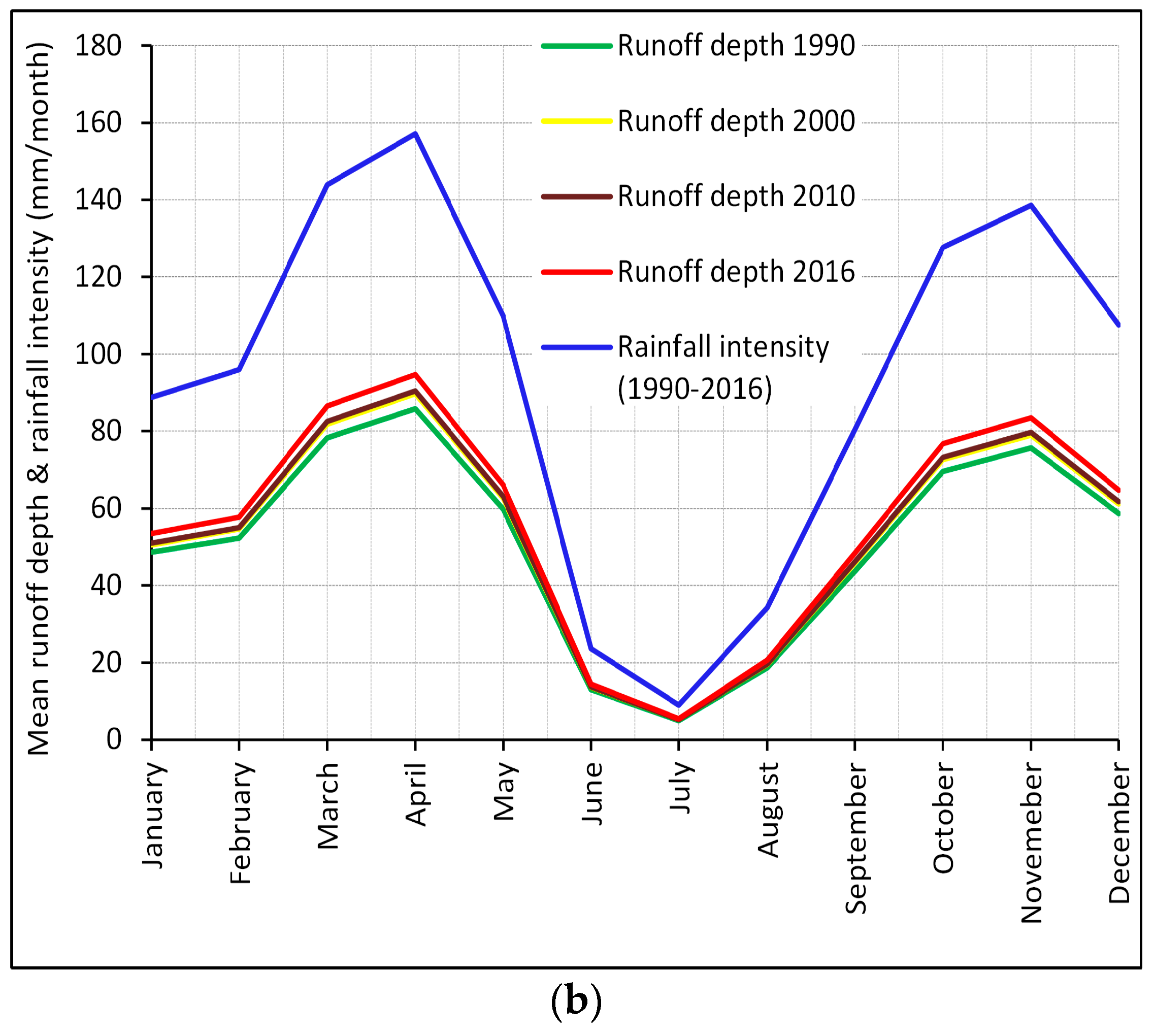
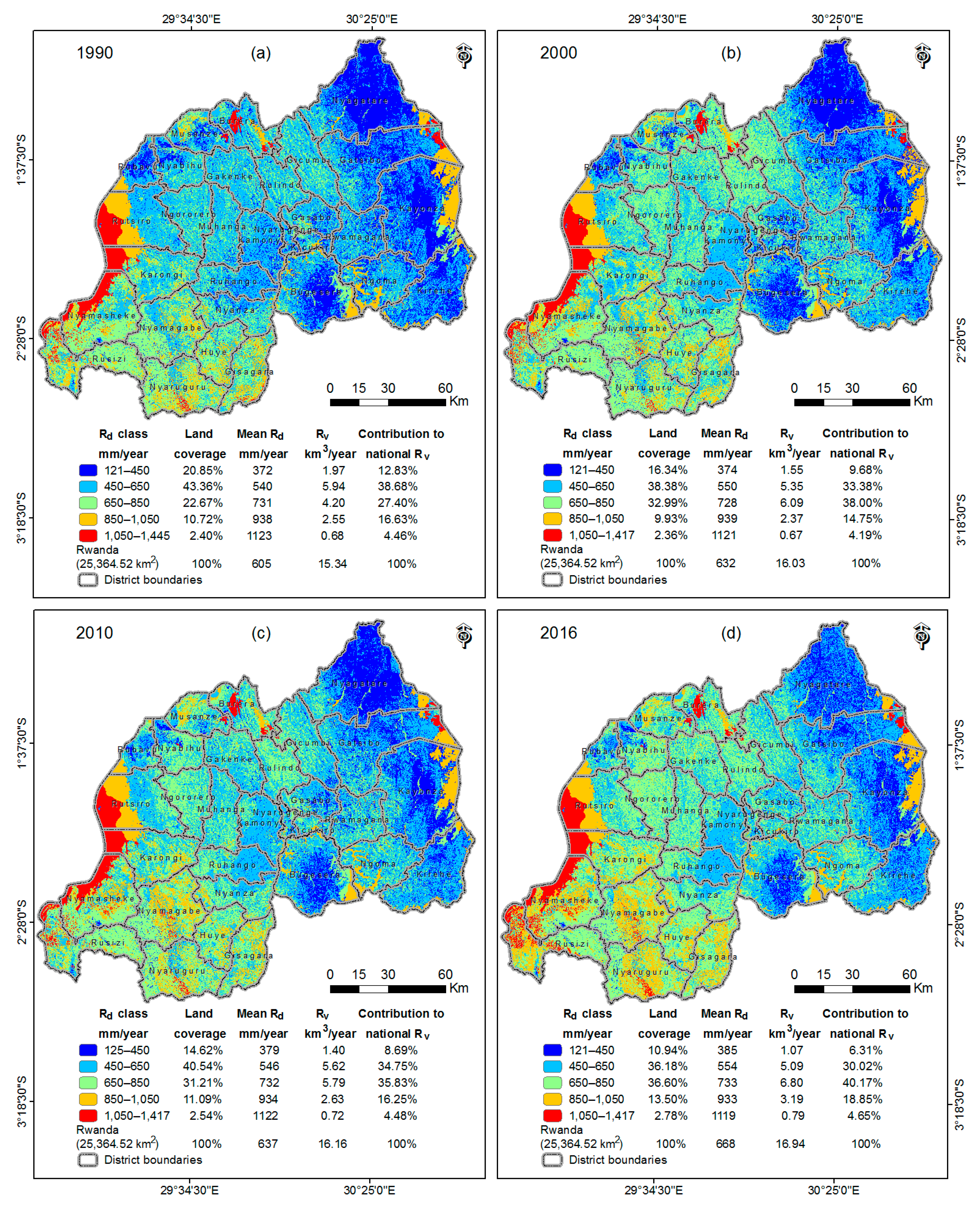
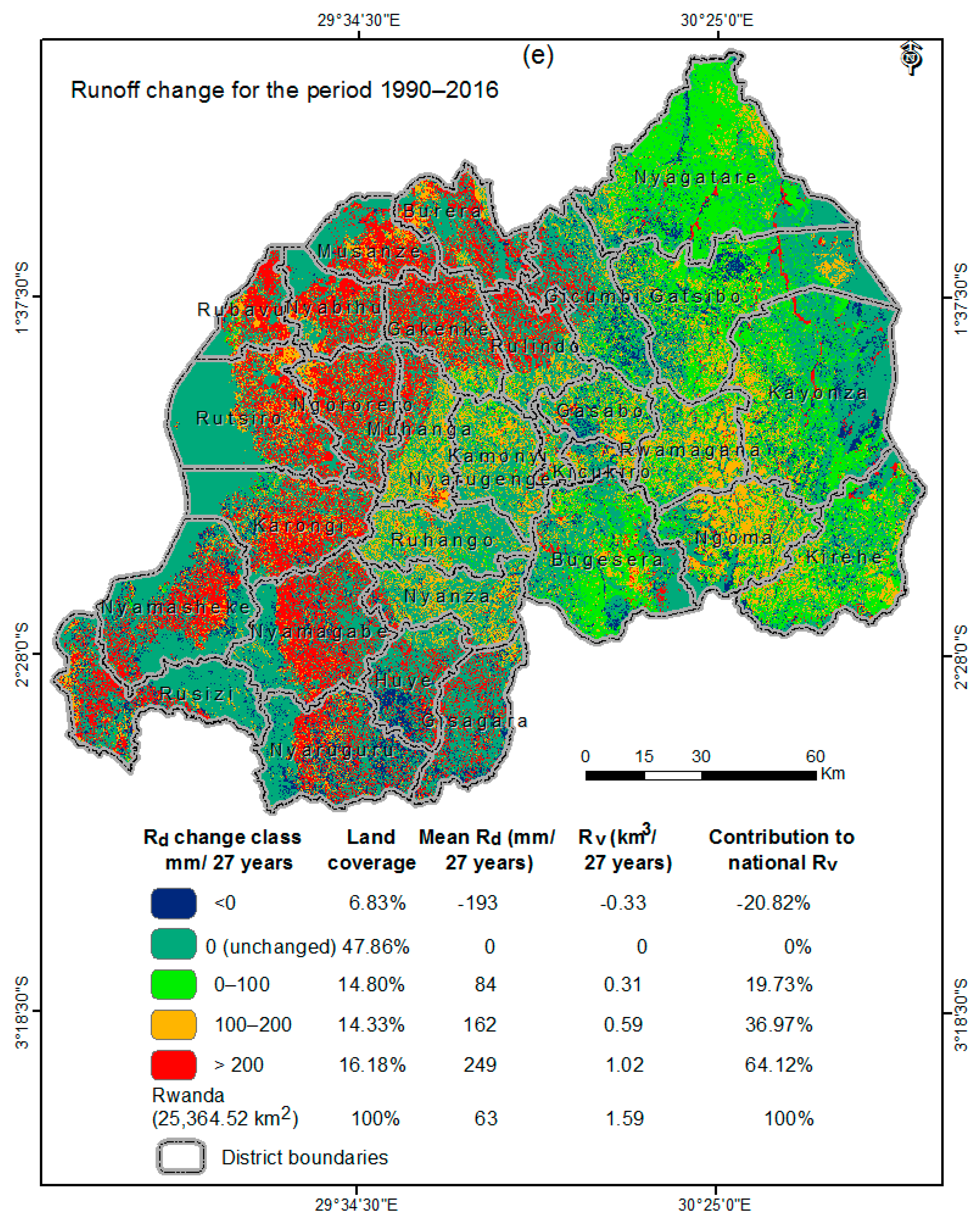
| Land Use | Slope (%) | Loam | Sandy Clay Loam | Clay Loam | Sandy Clay | Clay |
|---|---|---|---|---|---|---|
| Forestland | <0.5 | 0.13 | 0.23 | 0.27 | 0.33 | 0.40 |
| 0.5–5 | 0.17 | 0.27 | 0.31 | 0.37 | 0.44 | |
| 5–10 | 0.23 | 0.33 | 0.37 | 0.43 | 0.50 | |
| >10 | 0.35 | 0.45 | 0.49 | 0.55 | 0.62 | |
| Grassland | <0.5 | 0.23 | 0.33 | 0.37 | 0.43 | 0.50 |
| 0.5–5 | 0.27 | 0.37 | 0.41 | 0.47 | 0.54 | |
| 5–10 | 0.33 | 0.43 | 0.47 | 0.53 | 0.60 | |
| >10 | 0.45 | 0.55 | 0.59 | 0.65 | 0.72 | |
| Cropland | <0.5 | 0.33 | 0.43 | 0.47 | 0.53 | 0.60 |
| 0.5–5 | 0.37 | 0.47 | 0.51 | 0.57 | 0.64 | |
| 5–10 | 0.43 | 0.53 | 0.57 | 0.63 | 0.70 | |
| >10 | 0.55 | 0.65 | 0.69 | 0.75 | 0.82 | |
| Built-up land | <0.5 | 0.62 | 0.67 | 0.69 | 0.72 | 0.75 |
| 0.5–5 | 0.64 | 0.69 | 0.71 | 0.74 | 0.77 | |
| 5–10 | 0.67 | 0.72 | 0.74 | 0.77 | 0.80 | |
| >10 | 0.73 | 0.78 | 0.80 | 0.83 | 0.86 | |
| Wetland | <0.5 | 1.00 | 1.00 | 1.00 | 1.00 | 1.00 |
| 0.5–5 | 1.00 | 1.00 | 1.00 | 1.00 | 1.00 | |
| 5–10 | 1.00 | 1.00 | 1.00 | 1.00 | 1.00 | |
| >10 | 1.00 | 1.00 | 1.00 | 1.00 | 1.00 | |
| Water body | <0.5 | 1.00 | 1.00 | 1.00 | 1.00 | 1.00 |
| 0.5–5 | 1.00 | 1.00 | 1.00 | 1.00 | 1.00 | |
| 5–10 | 1.00 | 1.00 | 1.00 | 1.00 | 1.00 | |
| >10 | 1.00 | 1.00 | 1.00 | 1.00 | 1.00 |
| Land Use Category | (1) | (2) | (3) | (4) | (6) | (7) | ∑ | User Accuracy | Commission Error |
|---|---|---|---|---|---|---|---|---|---|
| (1) Forestland | 49 | 6 | 3 | 0 | 1 | 0 | 59 | 83.1% | 16.9% |
| (2) Grassland | 8 | 52 | 5 | 0 | 3 | 0 | 68 | 76.5% | 23.5% |
| (3) Cropland | 3 | 2 | 49 | 9 | 2 | 0 | 65 | 75.4% | 24.6% |
| (4) Built-up land | 0 | 0 | 1 | 51 | 0 | 0 | 52 | 98.1% | 1.9% |
| (5) Wetland | 0 | 0 | 2 | 0 | 52 | 0 | 54 | 96.3% | 3.7% |
| (6) Water bodies | 0 | 0 | 0 | 0 | 2 | 60 | 62 | 96.8% | 3.2% |
| ∑ | 60 | 60 | 60 | 60 | 60 | 60 | 360 | ||
| Producer accuracy | 81.7% | 86.7% | 81.7% | 85.0% | 86.7% | 100% | |||
| Omission error | 18.3% | 13.3% | 18.3% | 15.0% | 13.3% | 0.0% | |||
| Overall accuracy | 86.9% | ||||||||
| Kappa coefficient | 84.3% |
| Soil Texture Name | Sand | Silt | Clay |
|---|---|---|---|
| Sandy soil | 85–100 | 0–15 | 0–10 |
| Loamy sand | 70–90 | 0–30 | 0–15 |
| Sandy loam | 43–80 | 0–50 | 0–20 |
| Loam | 23–52 | 28–50 | 7–27 |
| Silt loam | 0–50 | 50–88 | 0–27 |
| Silt | 0–20 | 88–100 | 0–12 |
| Sandy clay loam | 45–80 | 0–28 | 20–35 |
| Clay loam | 20–45 | 15–53 | 27–40 |
| Silty clay loam | 0–20 | 40–73 | 27–40 |
| Sandy clay | 45–65 | 0–20 | 35–45 |
| Silty clay | 0–20 | 40–60 | 40–60 |
| Clay | 0–45 | 0–40 | 40–100 |
| Period | Forestland | Grassland | Cropland | Built-Up Land | Wetland | Water |
|---|---|---|---|---|---|---|
| 1990–2000 | −3444.50 | −1288.52 | 4996.81 | 22.83 | −286.62 | 0.00 |
| 2000–2010 | −154.72 | −40.58 | −109.07 | 71.02 | 215.60 | 17.76 |
| 2010–2016 | −3490.79 | −386.16 | 3616.01 | 261.17 | −3.98 | 3.76 |
| 1990–2016 | −7090.02 | −1715.26 | 8503.75 | 355.02 | −75.01 | 21.51 |
| Annual change | −262.59 | −63.53 | 314.95 | 13.15 | −2.78 | 0.80 |
| Land Use | Forestland | Grassland | Cropland | Built-Up Land | Wetland | Water | Total |
|---|---|---|---|---|---|---|---|
| Forestland | - | 1427.88 | 6183.41 | 178.73 | 138.29 | 32.15 | 7960.46 |
| Grassland | 432.06 | - | 3183.24 | 68.44 | 76.70 | 16.47 | 3776.91 |
| Cropland | 348.25 | 546.86 | - | 142.91 | 33.60 | 10.93 | 1082.55 |
| Built-up land | 4.44 | 3.61 | 36.84 | - | 0.33 | 0.01 | 45.23 |
| Wetland | 77.32 | 76.82 | 166.88 | 6.69 | - | 34.65 | 362.36 |
| Water bodies | 8.35 | 6.48 | 15.95 | 3.47 | 38.44 | - | 72.69 |
| Total | 870.42 | 2061.65 | 9586.32 | 400.24 | 287.36 | 94.21 | 13,300.20 |
| District | Mean Slope | Mean Rainfall | Mean Runoff Depth (Rd) | Runoff Volume (Rv) | |||||
|---|---|---|---|---|---|---|---|---|---|
| Names | Extent (Km2) | Angle (%) | mm/Year | mm/Year 2016 | Total Increase mm/27 Years | Annual Increase mm/Year | Annual Increase %/Year | Total Rv (km3/Year) 2016 | Contribution to National Rv (%) 2016 |
| Bugesera | 1296.13 | 9 | 926 | 585 | 35 | 1.3 | 0.24 | 0.76 | 4.48 |
| Burera | 646.80 | 26 | 1175 | 731 | 88 | 3.2 | 0.50 | 0.47 | 2.79 |
| Gakenke | 705.13 | 36 | 1145 | 658 | 102 | 3.8 | 0.68 | 0.46 | 2.74 |
| Gasabo | 431.20 | 23 | 1007 | 617 | 53 | 2.0 | 0.35 | 0.27 | 1.57 |
| Gatsibo | 1587.82 | 16 | 983 | 584 | 45 | 1.7 | 0.31 | 0.93 | 5.47 |
| Gicumbi | 829.42 | 34 | 1090 | 618 | 37 | 1.4 | 0.23 | 0.51 | 3.03 |
| Gisagara | 682.31 | 21 | 1145 | 768 | 19 | 0.7 | 0.09 | 0.52 | 3.09 |
| Huye | 583.38 | 23 | 1154 | 744 | 38 | 1.4 | 0.20 | 0.43 | 2.56 |
| Kamonyi | 662.01 | 21 | 1004 | 599 | 59 | 2.2 | 0.41 | 0.40 | 2.34 |
| Karongi | 989.22 | 27 | 1194 | 793 | 82 | 3.0 | 0.43 | 0.78 | 4.63 |
| Kayonza | 1937.85 | 14 | 946 | 549 | 30 | 1.1 | 0.21 | 1.06 | 6.28 |
| Kicukiro | 167.41 | 12 | 970 | 639 | 41 | 1.5 | 0.26 | 0.11 | 0.63 |
| Kirehe | 1192.13 | 16 | 956 | 572 | 63 | 2.3 | 0.46 | 0.68 | 4.02 |
| Muhanga | 646.80 | 32 | 1100 | 643 | 98 | 3.6 | 0.66 | 0.42 | 2.45 |
| Musanze | 527.58 | 19 | 1354 | 709 | 103 | 3.8 | 0.63 | 0.37 | 2.21 |
| Ngoma | 872.54 | 15 | 997 | 671 | 79 | 2.9 | 0.50 | 0.59 | 3.46 |
| Ngororero | 677.23 | 36 | 1200 | 709 | 108 | 4.0 | 0.67 | 0.48 | 2.84 |
| Nyabihu | 537.73 | 32 | 1307 | 696 | 113 | 4.2 | 0.72 | 0.37 | 2.21 |
| Nyagatare | 1922.63 | 13 | 921 | 501 | 58 | 2.1 | 0.49 | 0.96 | 5.69 |
| Nyamagabe | 1093.21 | 32 | 1336 | 765 | 86 | 3.2 | 0.47 | 0.84 | 4.94 |
| Nyamasheke | 1171.84 | 26 | 1376 | 856 | 54 | 2.0 | 0.25 | 1.00 | 5.92 |
| Nyanza | 672.16 | 20 | 1057 | 670 | 61 | 2.2 | 0.37 | 0.45 | 2.66 |
| Nyarugenge | 131.90 | 22 | 1006 | 623 | 43 | 1.6 | 0.27 | 0.08 | 0.49 |
| Nyaruguru | 1012.04 | 30 | 1376 | 771 | 41 | 1.5 | 0.21 | 0.78 | 4.60 |
| Rubavu | 388.08 | 17 | 1199 | 666 | 128 | 4.7 | 0.88 | 0.26 | 1.53 |
| Ruhango | 626.50 | 20 | 1027 | 613 | 64 | 2.4 | 0.43 | 0.38 | 2.27 |
| Rulindo | 568.17 | 34 | 1116 | 656 | 86 | 3.2 | 0.56 | 0.37 | 2.20 |
| Rusizi | 961.32 | 29 | 1450 | 824 | 49 | 1.8 | 0.23 | 0.79 | 4.68 |
| Rutsiro | 1161.70 | 19 | 1177 | 824 | 64 | 2.4 | 0.31 | 0.96 | 5.65 |
| Rwamagana | 682.31 | 15 | 957 | 642 | 86 | 3.2 | 0.57 | 0.44 | 2.59 |
| Rwanda | 25,364.52 | 22 | 1116 | 668 | 63 | 2.3 | 0.38 | 16.94 | 100 |
| Calculations | Description | Extent | T | U | V = T × U × 10−8 |
|---|---|---|---|---|---|
| Area (ha) | Depth or Intensity (mm) | Volume (km3/T) | |||
| A | Available wet season rainwater/7 months | Total Rwanda | 2,536,452 | 865 | 21.94 |
| B | Available dry season rainwater/5 months | Total Rwanda | 2,536,452 | 251 | 6.37 |
| C = A + B | Available rainwater/year (all seasons) | Total Rwanda | 2,536,452 | 1116 | 28.31 |
| D | Available wet season runoff/7 months | Total Rwanda | 2,536,452 | 516 | 13.09 |
| F | Available dry season runoff/5 months | Total Rwanda | 2,536,452 | 152 | 3.86 |
| G = D + F | Available runoff/1 year (all seasons) | Total Rwanda | 2,536,452 | 668 | 16.94 |
| H | Irrigation water requirement/7 months (wet season) | Cropland 2016 | 1,478,752 | 729 | 10.78 |
| I | Irrigation water requirement/5 months (dry season) | Cropland 2016 | 1,478,752 | 521 | 7.70 |
| J = H + I | Irrigation water requirement/1 year | Cropland 2016 | 1,478,752 | 1250 | 18.48 |
| K | Available wet season rainwater/7 months | Cropland 2016 | 1,478,752 | 865 | 12.79 |
| L | Available dry season rainwater/5 months | Cropland 2016 | 1,478,752 | 251 | 3.71 |
| M = K + I | Total available rainwater/1 year (all seasons) | Cropland 2016 | 1,478,752 | 1116 | 16.50 |
| N = K − H | Surplus in rainwater based on irrigation/7 months (wet season) | Cropland 2016 | 1,478,752 | 136 | 2.01 |
| O = I − L | Deficit in rainwater based on irrigation/5 months (dry season) | Cropland 2016 | 1,478,752 | 270 | 3.99 |
| P = J − M | Deficit in rainwater based on irrigation/1 year | Cropland 2016 | 1,478,752 | 134 | 1.98 |
| R = D − O | Extra wet season runoff after meeting the gap in rainfall based on irrigation of the cropland during dry season | Total Rwanda | 2,536,452 | 246 | 6.24 |
| S = F + R | Extra runoff after meeting the gap in rainfall based on irrigation of the cropland/1 year | Total Rwanda | 2,536,452 | 398 | 10.10 |
© 2017 by the authors. Licensee MDPI, Basel, Switzerland. This article is an open access article distributed under the terms and conditions of the Creative Commons Attribution (CC BY) license ( http://creativecommons.org/licenses/by/4.0/).
Share and Cite
Karamage, F.; Zhang, C.; Fang, X.; Liu, T.; Ndayisaba, F.; Nahayo, L.; Kayiranga, A.; Nsengiyumva, J.B. Modeling Rainfall-Runoff Response to Land Use and Land Cover Change in Rwanda (1990–2016). Water 2017, 9, 147. https://doi.org/10.3390/w9020147
Karamage F, Zhang C, Fang X, Liu T, Ndayisaba F, Nahayo L, Kayiranga A, Nsengiyumva JB. Modeling Rainfall-Runoff Response to Land Use and Land Cover Change in Rwanda (1990–2016). Water. 2017; 9(2):147. https://doi.org/10.3390/w9020147
Chicago/Turabian StyleKaramage, Fidele, Chi Zhang, Xia Fang, Tong Liu, Felix Ndayisaba, Lamek Nahayo, Alphonse Kayiranga, and Jean Baptiste Nsengiyumva. 2017. "Modeling Rainfall-Runoff Response to Land Use and Land Cover Change in Rwanda (1990–2016)" Water 9, no. 2: 147. https://doi.org/10.3390/w9020147
APA StyleKaramage, F., Zhang, C., Fang, X., Liu, T., Ndayisaba, F., Nahayo, L., Kayiranga, A., & Nsengiyumva, J. B. (2017). Modeling Rainfall-Runoff Response to Land Use and Land Cover Change in Rwanda (1990–2016). Water, 9(2), 147. https://doi.org/10.3390/w9020147







